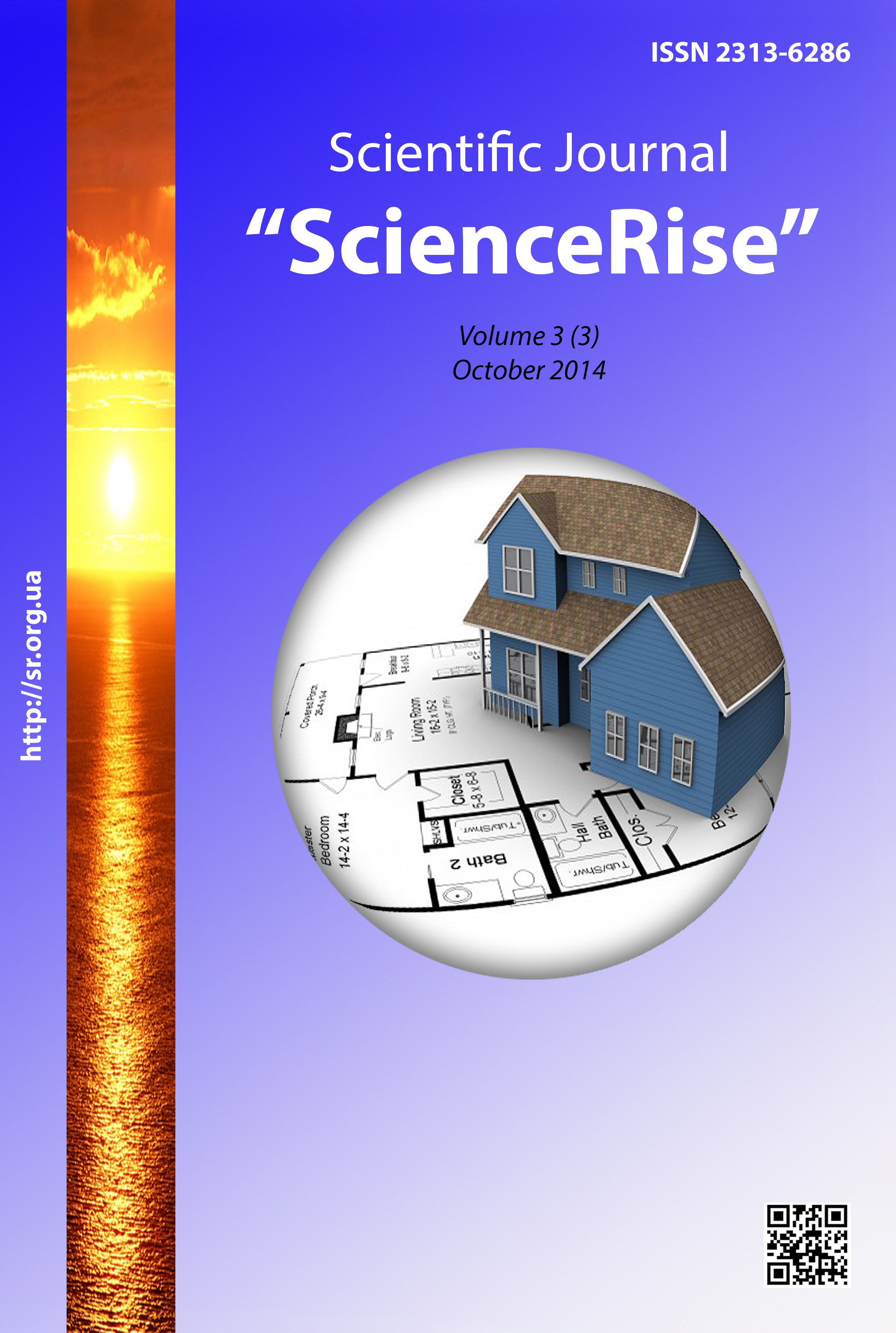Оброблення зображень плям лазерних пучків із застосуванням паралельно-ієрархічних мереж
DOI:
https://doi.org/10.15587/2313-8416.2014.27536Słowa kluczowe:
класифікація, плямоподібне зображення профілю лазерного променя, енергетичний центрAbstrakt
Представлено основні етапи для класифікації та прогнозування координат енергетичних центрів зображень плям лазерного променя, що дає можливість розробити нову інтелектуальну технологію для їх класифікації та прогнозування положення координат їх енергетичних центрів. Проведено експерименти з порівняльної оцінки прогнозування на основі відомих нейронних мереж і запропонованого методу з використанням паралельно-ієрархічної мережі.
Bibliografia
1. Kozhem'iako, V. P., Tymchenko, L. I., Kutaev, Yu. F., Ivasiuk, I. D. (1994). Vstup v alhorytmichnu teoriiu iierarkhii i paralelizmu nejropodibnykh obchysliuval'nykh seredovysch ta ii zastosuvannia do peretvorennia zobrazhen'. Osnovy teorii piramidal'no sit'ovoho peretvorennia zobrazhen' [Introduction to algorithmic theory of hierarchy and parallelism neural computing environments and its application to image conversion. Basic theory of network pyramid image conversion]. Kyiv: UMK VO, 272. [in Ukrainian].
2. Kozhem'iako, V. P., Tymchenko, L. I., Yarovyj, A. A. (2005). Paralel'no-iierarkhichni merezhi iak strukturno-funktsional'nyj bazys dlia pobudovy spetsializovanykh modelej obraznoho komp'iutera [Parallel-hierarchical network as a structural and functional basis for building specialized models shaped computer]. Vinnytsia: Universum-Vinnytsia, 161. [in Ukrainian].
3. Yarovyj, A. A., Kokriats'ka, N. I., Nakonechna, S. V., Matejchuk, M. S., Pol'hul', T. D. (2014). Analiz obchysliuval'noi skladnosti GPU-oriientovanykh paralel'no-iierarkhichnykh obchysliuval'nykh system ta otsiniuvannia produktyvnosti ikh aparatnoho zabezpechennia [Analysis of computational complexity GPU-oriented hierarchical parallel computing and performance evaluation of hardware]. Optyko-elektronni informatsijno-enerhetychni tekhnolohii – Opto-electron Information technology the energy, 1 (27), 18–25 [in Ukrainian].
4. Orlov, D. A., Neverova, E. A. (2011). Determination of the position of the center of a laser beam when the dynamic range of the matrix receiver is exceeded. Measurement Techniques, 10 (53), 1140–1146 [in English]. http://dx.doi.org/10.1007/s11018-011-9631-1
5. Poplavskiy, A. A., Timchenko, L. I., Kokryatskaya, N. I., Poplavskiy, A. V. (2010). Ispolzovanie gradientnyih masok dlya byistrogo opredeleniya tsentrov izobrazheniy pyaten lazernyih puchkov s povyishennoy tochnostyu [Using gradient masks for the rapid determination of the centers of spot images of laser beams with high accuracy]. Shtuchniy Intelekt – Artificial Intelligence, 3, 422–426 [in Russian].
6. Tymchenko, L. I., Mel'nikov, V. V., Kokriats'ka, N. I. (2008). Metod znakhodzhennia enerhetychnykh tsentriv frahmentiv lazernykh protiazhnykh tras v real'nomu masshtabi chasu dlia rozpiznavannia obraziv [The method of the energy centers of fragments laser longest runs in real-time pattern recognition], pr. 9-i vseukr. mizhnar. konf. Obroblennia syhnaliv i zobrazhen' ta rozpiznavannia obraziv – Signal processing and image and pattern recognition, 213–216 [in Ukrainian].
7. Tymchenko, L. I., Kokriats'ka, N. I., Mel'nikov, V. V., Nakonechna, S. V. (2012). Novyj metod prohnozuvannia iz zastosuvanniam paralel'no-iierarkhichnoi merezhi [A new forecasting method using the parallel-hierarchical network], materialy mizhnar. nauk.-tekhn. konf. Shtuchnyj intelekt. Intelektual'ni systemy – Artificial Intelligence. Intelligent Systems, 59–62 [in Ukrainian].
8. Tymchenko, L. I., Kokriats'ka, N. I., Mel'nikov, V. V., Nakonechna, S. V. (2012). Novyj metod prohnozuvannia iz zastosuvanniam paralel'no-iierarkhichnoi merezhi [A new forecasting method using the parallel-hierarchical network]. Shtuchnyj intelekt – Artificial Intelligence, 3, 96–104 [in Ukrainian].
9. Timchenko, L., Poplavskyy, A., Petrovskyi, N. (2011). Method of reference tunnel formation for improving forecast results of the laser beams spot images behavior. J. Opt. Eng, 50 (11), 1–8 [in English]. http://dx.doi.org/10.1117/1.3655502
10. Abdrahmanov, K. Sh., Byikova, O. G., Ulanovskiy, M. V. (2010). Standartizatsiya metodov izmereniy shirin, uglov rashodimosti i koeffitsientov rasprostraneniya puchkov lazernogo izlucheniya (Izmerenie rashodimosti lazernogo puchka) [Standardization of methods of measurement of width, divergence angles and beam propagation ratios of laser radiation (laser beam divergence measurement)]. Metrologiya – Metrology, 2, 23–44 [in Russian].
11. Byikova, A. G., Liberman, A. A., Ulanovskiy, M. V. (2009). Standartizovannyie metodiki izmereniy moschnosti, energii i vremennyih harakteristik lazernogo puchka [Standardized methods of measuring power, energy and temporal characteristics of the laser beam]. Metrologiya – Metrology, 12, 15–30 [in Russian].
12. Fujiwara, Y., Mokuno, M., Jono, T., Yamawaki, K., Arai, M., Toyoshima, H., Kunimori, Z., Sodnik, A., Bird, B. (2007). Demelenne Optical inter-orbit communications engineering test Satellite. Acta Astronautіса, 61 (1-6), 163–175 [in English]. http://dx.doi.org/10.1016/j.actaastro.2007.01.021
13. Garcia-Zambrana, A., Castillo-Vazquez, C., Castillo-Vazquez, B. (2010). Space-time trellis coding with transmit laser selection for FSO links over strong atmospheric turbulence channels. Optics Express, 18 (6), 5356–5366 [in English]. http://dx.doi.org/10.1364/oe.18.005356
14. Borovikov, V. P. (2003). Statistica. Iskusstvo analiza dannyih na kompyutere [Statistica. Art computer data analysis]. SPb.: Piter, 688. [in Russian].##submission.downloads##
Opublikowane
Numer
Dział
Licencja
Copyright (c) 2014 Леонід Іванович Тимченко, Світлана Вячеславівна Наконечна

Utwór dostępny jest na licencji Creative Commons Uznanie autorstwa 4.0 Międzynarodowe.
Our journal abides by the Creative Commons CC BY copyright rights and permissions for open access journals.
Authors, who are published in this journal, agree to the following conditions:
1. The authors reserve the right to authorship of the work and pass the first publication right of this work to the journal under the terms of a Creative Commons CC BY, which allows others to freely distribute the published research with the obligatory reference to the authors of the original work and the first publication of the work in this journal.
2. The authors have the right to conclude separate supplement agreements that relate to non-exclusive work distribution in the form in which it has been published by the journal (for example, to upload the work to the online storage of the journal or publish it as part of a monograph), provided that the reference to the first publication of the work in this journal is included.

